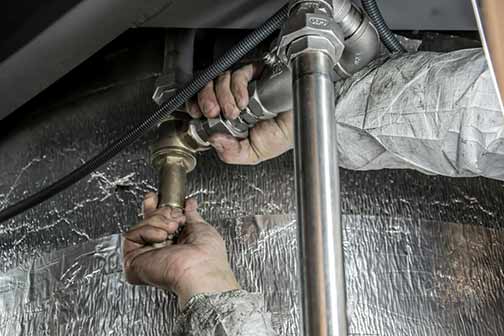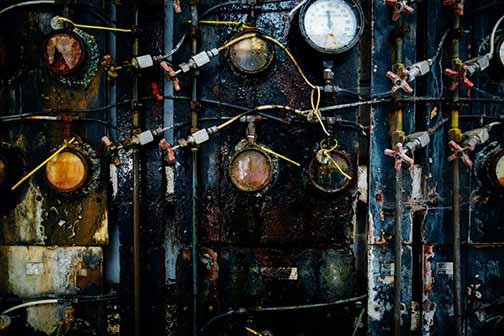
A strong foundation is essential for a safe and stable home. However, underground plumbing issues can silently weaken the soil beneath, leading to cracks, uneven floors, and structural instability. Leaking pipes, sewer line breaks, and poor drainage disturb the ground, causing foundation movement over time. As a matter of fact, even a slow leak can create serious damage if left unchecked.
Apart from annual plumbing checks, learning to recognize the warning signs can save you a lot of stress. In areas with shifting soil conditions, plumbing leaks can accelerate foundation problems by increasing soil expansion and contraction. Not to mention, unnoticed moisture buildup can lead to mold growth and costly repairs.
How Underground Plumbing Issues Threaten Structural Stability
Water is one of the biggest threats to foundation stability. When underground pipes leak, water saturates the soil around and beneath the foundation. As the soil absorbs excess water, it expands. When it dries, it shrinks. This continuous cycle of expansion and contraction puts stress on the foundation. Of course, this weakens the structure over time.
Different soil types react differently to moisture changes. Clay-heavy soil swells when wet and shrinks when dry, creating movement that causes foundation cracks. Sandy or gravel-based soil allows water to flow through, which can lead to erosion beneath the foundation. In contrast, poorly compacted soil washes away faster when exposed to leaking water. Leaks that go unnoticed for long periods create voids under the foundation. These empty spaces reduce support, causing parts of the foundation to sink. Besides, shifting soil can result in uneven weight distribution, leading to cracks and misalignment of the structure.

Environmental Factors Affecting Underground Plumbing Integrity
Tree roots are another major factor. Roots naturally seek moisture and often invade underground pipes. As they grow, they cause cracks in the pipes, creating leaks that worsen foundation instability. As an illustration, older homes with outdated plumbing are more susceptible to these issues due to weakened materials. Extreme weather conditions can also contribute. Freezing temperatures may cause pipes to crack, leading to slow leaks that destabilize the soil. Underground pipes are particularly vulnerable to sudden temperature changes, which increase pressure on aging plumbing systems.
When relocation to places with shifting soil conditions, like Louisiana or Illinois, you should thing about hiring residential movers. It’s important to inspect the plumbing system before settling into a new home, and professional movers will know what to look for. Undetected leaks can lead to expensive foundation repairs down the line. To avoid costly mistakes, always trust the task to trained people when inspecting or repairing underground plumbing issues. Professional plumbers use specialized tools to detect leaks and prevent long-term damage.

Common Plumbing Problems That Affect Your Foundation
Several underground plumbing problems contribute to foundation instability. Broken sewer lines are a major issue because they release wastewater into the soil, causing it to soften and shift. The longer the leak persists, the more the ground destabilizes. Another key point, sudden pipe breaks cause an immediate rush of water, leading to rapid soil movement.
Corroded pipes develop small leaks that go unnoticed until serious damage occurs. Over time, metal pipes degrade, releasing moisture into the surrounding soil. Additionally, drainage systems that are not maintained allow rainwater and plumbing runoff to accumulate near the foundation, making the soil overly saturated.
Signs of Foundation Damage Caused by Plumbing Issues
Foundation damage often starts with small warning signs. Cracks appearing in walls and ceilings indicate that the structure is shifting. Uneven or sloping floors suggest that parts of the foundation are sinking. Doors and windows that stick or don’t close properly signal movement in the foundation. As the structure shifts, frames become misaligned. Not to mention, flooring gaps and separated baseboards indicate serious movement beneath the home.
Moisture buildup inside the home is another red flag. Increased humidity, damp spots on walls, and mold growth are signs of a hidden leak. Of course, unexplained spikes in water bills can also signal underground plumbing issues. An unusual musty odor may indicate excess moisture in crawl spaces or basements. If left unchecked for a long time, this can create ideal conditions for mold and mildew growth. Another key point, persistent dampness weakens wood framing, leading to structural deterioration.

Why Ignoring Plumbing Leaks Can Lead to Costly Repairs
Many homeowners underestimate the long-term damage caused by small plumbing leaks. Ignoring these leaks allows moisture to continuously weaken the foundation. Over time, minor cracks expand into serious structural problems that require extensive repairs. Continuous moisture exposure weakens concrete and wooden foundation elements. Concrete absorbs water, leading to erosion, while wood becomes vulnerable to rot. Besides, mold and mildew thrive in damp conditions, affecting indoor air quality and creating health risks.
Foundation repairs are expensive. Simple crack repairs cost hundreds of dollars, but major structural reinforcement can reach tens of thousands. In contrast, fixing leaks early prevents larger structural failures. A compromised foundation also affects home value. Buyers avoid properties with foundation issues, leading to reduced market value. With this in mind, regular plumbing maintenance prevents expensive repairs and preserves property value.
Preventive Measures to Protect Your Home’s Foundation
Taking preventive steps reduces the risk of foundation damage. Regular plumbing inspections help detect leaks before they cause major issues. Hiring professionals to detect underground pipe leaks ensures early detection of weak spots. As an illustration, plumbers use camera inspections to check for hidden leaks without digging. Proper drainage systems prevent excess moisture from accumulating around the foundation. French drains and well-maintained sump pumps help direct water away from the home. Moisture barriers prevent soil from expanding and contracting due to excessive water exposure.
Tree placement also plays a role in preventing plumbing damage. Trees should be planted away from underground pipes to avoid root intrusion. Another key point, choosing slow-growing tree species reduces the risk of root-related leaks. Smart home technology can also help. Leak detection devices monitor water usage and send alerts if a leak is detected. Installing water pressure regulators prevents pipe stress, reducing the risk of unexpected breaks.
When to Call a Professional Plumber and Structural Engineer
If multiple foundation damage signs appear, professional help is necessary. A plumber can check underground pipes for hidden leaks using hydrostatic testing. This method detects pressure drops that indicate leaks. Besides, trenchless pipe repair offers a non-invasive way to fix leaks without extensive digging.
A structural engineer assesses how foundation shifts affect the home’s stability. They determine whether soil erosion or plumbing issues are causing the problem. Of course, waiting too long increases repair costs and risks permanent damage. A homeowner should call a professional if they notice water pooling near the foundation. With this in mind, early intervention prevents further weakening of the structure.
Summary: Protect Your Home from Hidden Plumbing Threats
Underground plumbing issues pose a major risk to a home’s foundation. Small leaks cause gradual damage, leading to major structural problems if ignored. As a matter of fact, unnoticed leaks are one of the leading causes of foundation movement.
Regular inspections, proper drainage, and early repairs help prevent severe damage. Fixing plumbing leaks early protects both the home’s structural integrity and its market value. In contrast, ignoring leaks leads to costly repairs and long-term stability issues.

